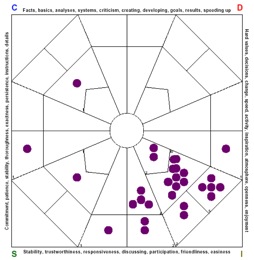One Size Does Not Fit AllWritten on the 22 July 2014 by Markku Kauppinen, Extended DISC North America ) Employee turnover is an expensive problem that many managers and companies struggle with. It can be a very frustrating issue because not only does it cost a lot of money but it also can be a source of constant headaches for the management.Just this week I was talking with a senior consultant of one of our affiliates that has been working with a client that was experiencing a 400% turnover on their “graveyard” or third shift. The client company is a California based convenience store group.
I know, I know. You would expect a fairly high turnover rate in this type of a job. However, a 400% turnover rate is still hard to stomach no matter what business you are in. Not only that, many of the employees quit their jobs without a notice - they simply did not show up one day or they walked off the job when they for some reason simply had had enough. In those situations it was straight into the crisis mode: unattended store is not a good thing.
How would you like to get a call at 2:00 am letting you know that you need to fill in NOW because one of your employees did not show up? Maybe you have.
The situation was intolerable. As a result, the company decided to conduct an analysis of employees that quit on the night shift. Perhaps something could be done.
The results of the analysis were simply startling – 87% of the employees that quit were of the same behavioral style! Not only that, all of the employees that quit without a notice and simply decided not to show up one day or walked off the job were also part of this group. All of the remaining 13% who were of different styles gave the required two-week notice giving the management enough time to hire a new employee or make other necessary adjustments. Table 1. Lost Employees  All of the employees that quit without a notice and simply decided not to show up one day or walked off the job were also part of this group. The remaining 13% who were of different styles all gave the required notice.
The analysis revealed that the managers were hiring outgoing, personable individuals who were likely to get along with customers. This was understandable based on the desire of the company to have outgoing and friendly clerks in their stores. It makes good sense. However, the reality of the night shift is that there is an only sporadic flow of customers and no co-workers to talk with. It is a lonely job that does not fit the behavioral style of individuals who are good with people and enjoy interacting with others. In contrast, the day shifts offer both a steady flow of customers and co-workers that are there to help with demands of the higher customer traffic.
The managers decided to start hiring people that were more suited for the requirements of the night shift – individuals who do not need as much contact with others and who even enjoy the quiet routine of the job. Another interesting finding of the analysis: the managers realized that they would have never considered these styles of employees before because they did not seem “friendly” enough in the interviews. On the other hand, the employees that had been hired in the past came across as very personable and people-oriented. These were both traits that seemed to create better customers experiences. Certainly true until the day no one was behind the counter.
How about the real, business results? One year after implementing the new hiring process, the employee turnover on the night shift has been reduced to from 400% to 50%. The savings are obviously significant.
The success on the night shift has given the impetus for additional analysis and new ways of making sure that the right people are doing the right jobs. The analysis is now conducted not only based on the shift but also on the type of store and location.
For example, it was discovered that styles of individuals that did not succeed in the night shift excelled in the day shifts at the company’s full-service service station locations. Apparently, the outgoing, talkative employees made a stop to a gas station a more pleasant chore. As a result, the per store gasoline sales were increased by the more loyal customers.
I suspect that you do not have to deal with these types of issues today. However, one day you may have to. Do you have a plan in place to ensure that everyone sleeps well at night?
|



